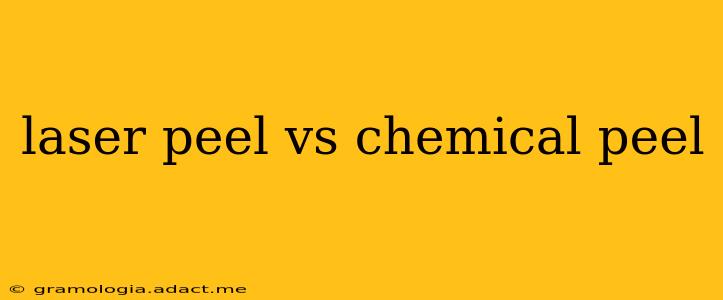Choosing between a laser peel and a chemical peel can feel overwhelming. Both procedures aim to rejuvenate the skin, reducing wrinkles, acne scars, and age spots, but they achieve this through different mechanisms. This comprehensive guide will delve into the key differences, helping you make an informed decision about which treatment best suits your skin concerns and goals.
What is a Laser Peel?
A laser peel uses a highly focused beam of light to remove the outer layers of skin. The intensity of the laser determines the depth of the peel, ranging from superficial to deep. This controlled ablation stimulates collagen production, resulting in smoother, firmer skin. Different laser types target specific skin issues, offering customizable treatment plans. For example, ablative lasers remove more skin tissue, ideal for deeper wrinkles and scars, while non-ablative lasers penetrate less deeply, focusing on texture and tone improvement.
Types of Laser Peels:
- Ablative Laser Peels: These cause more visible damage and require longer recovery times. They are suitable for addressing deeper wrinkles, significant acne scarring, and sun damage.
- Non-ablative Laser Peels: These cause minimal visible damage and have shorter recovery periods. They are ideal for improving skin texture, tone, and mild wrinkles.
What is a Chemical Peel?
A chemical peel uses a chemical solution to exfoliate the skin. The depth of the peel depends on the type and concentration of the chemical solution used. Like laser peels, chemical peels stimulate collagen production, improving skin texture and tone. However, chemical peels work by causing controlled damage to the outer layers of the skin, prompting the body’s natural healing process to regenerate new skin cells.
Types of Chemical Peels:
- Superficial Peels: These use mild acids like glycolic acid or salicylic acid, targeting superficial imperfections like mild acne, uneven skin tone, and fine lines. Recovery time is minimal.
- Medium Peels: These utilize stronger acids like trichloroacetic acid (TCA), addressing moderate acne scars, sun damage, and wrinkles. Recovery time is longer, with some peeling and redness.
- Deep Peels: These employ strong phenol solutions, treating deep wrinkles, severe acne scarring, and precancerous lesions. They require the longest recovery time and are typically performed in a clinical setting.
Laser Peel vs. Chemical Peel: Key Differences
| Feature | Laser Peel | Chemical Peel |
|---|---|---|
| Mechanism | Laser ablation removes skin layers | Chemical solution exfoliates skin layers |
| Depth of Peel | Superficial to deep, customizable | Superficial, medium, or deep |
| Recovery Time | Varies greatly depending on depth of peel | Varies greatly depending on depth of peel |
| Cost | Generally more expensive | Generally less expensive |
| Precision | Highly precise targeting of specific areas | Less precise, affects a larger area |
| Suitable for | Wrinkles, scars, sun damage, pigmentation | Wrinkles, scars, sun damage, pigmentation |
Which Treatment is Right for Me?
The best treatment depends on individual needs and preferences. Consider these factors:
- Severity of Skin Concerns: Deep wrinkles and severe scarring might benefit from a laser peel, while superficial concerns can be addressed with a chemical peel.
- Skin Type and Tone: Certain skin types might be more suitable for one treatment over the other. A consultation with a dermatologist is crucial to determine suitability.
- Downtime Tolerance: Laser peels, particularly ablative ones, often involve significant downtime. Chemical peels offer varying degrees of downtime, depending on the depth.
- Budget: Laser peels tend to be more expensive than chemical peels.
What are the side effects of laser peels and chemical peels?
Both laser and chemical peels can cause side effects, including redness, swelling, and peeling. The severity of side effects depends on the type of peel and the individual's skin. Laser peels may also cause blistering or hyperpigmentation in some cases. It's essential to discuss potential risks and side effects with a qualified dermatologist before undergoing either treatment.
How long do the results last?
The longevity of results depends on several factors, including the individual's skin type, age, lifestyle, and sun exposure. While both treatments can provide significant improvements, results are not permanent. Maintaining healthy skin habits, such as using sunscreen daily, can help prolong the effects.
How much do laser and chemical peels cost?
The cost of laser and chemical peels varies greatly depending on the type of peel, the location, and the dermatologist's fees. It's essential to consult with a dermatologist to get a personalized cost estimate.
Choosing between a laser peel and a chemical peel requires careful consideration of your individual needs and preferences. Always consult with a qualified dermatologist or plastic surgeon to discuss which treatment is best suited for you and to address any concerns you might have. They can assess your skin condition, discuss your goals, and provide a personalized treatment plan. Remember, the goal is to improve your skin's health and appearance safely and effectively.
